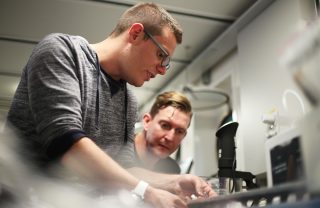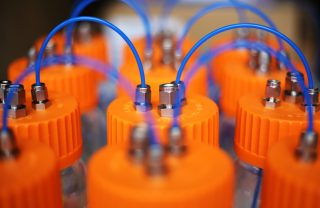As humans, we breathe in oxygen and breathe out carbon dioxide—if we ran out of oxygen we would be in trouble. But in some parts of the ocean, where oxygen levels hit rock bottom, life persists in the form of resilient bacteria and archaea.
Instead of suffocating from lack of oxygen, these microbes have special traits that enable them to do more than simply adapt to a habitat without oxygen—they actually alter the chemistry of their aquatic environment. Instead of breathing in oxygen, these microbes consume several different chemicals in much the same way our bodies ingest sugar and carbohydrates to make energy.
For example, some of these organisms take in ammonium, convert it in their tiny cells, and then expel nitrous oxide. This is just one of several processes they execute constantly. In so doing, these microbes have a massive impact on the biogeochemical systems in the ocean and our planet as a whole.

A String of Pearls Around the Milky Way
“If you were to strand all the bacteria in the ocean end to end, like a string of pearls, it would stretch fifty times around the Milky Way,” says Chief Scientist Andrew Babbin. “Because there are so many of them, they have the power to transform the earth.”
As the planet warms, oxygen becomes less soluble in the ocean, which means the amount of anoxic (depleted of dissolved oxygen) water is increasing. With low oxygen zones becoming more prevalent, understanding their organisms is paramount.
“We want to identify the chemical cues these microbes utilize to do their thing,”says Babbin. “Will they de-nitrify, or respire oxygen, or do some other crazy metabolism that no one has ever thought of, but probably exists because there are so many of them?”

On R/V Falkor, Babbin and his team will deploy in-situ incubators—devices that send specialized chambers down to various depths and stay there, collecting data for up to 24 hours. This new method allows the scientists to examine the living conditions of these microbes without changing their oxygen concentrations, depth, light level, or any parameters that could impact how the tiny lifeforms function.
“Low oxygen zones account for less than 0.1 percent of the ocean’s volume, but they are the only place in the water column where fixed nitrogen loss occurs,” Babbin says.
When these microorganisms run out of oxygen, they look for other sources of energy. The next best form is usually fixed nitrogen, which functions as a fertilizer for phytoplankton. Instead of harnessing the fixed nitrogen for growth, these microbes convert it into nitrogen gas, which in turn limits the potential for phytoplankton growth.

Despite their small scale relative to the whole ocean, the feedbacks generated in low oxygen waters have a huge impact on the entirety of earth’s climate.
“As the climate changes and these areas expand, we don’t know exactly what’s going to happen,” Babbin says. “We’re here to try to understand the intricate interactions between microorganisms and the chemistry of their environment.”

